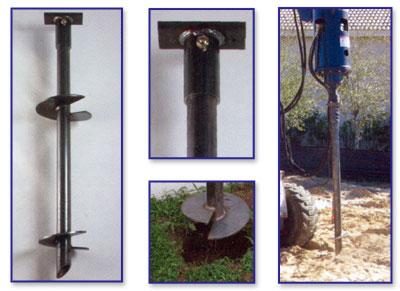These procedures are highly technical and the crews are very specialized. Push Pier SystemSigns of Foundation Failure:
Grip-Tite Push Pier System® Helps you avoid further serious, costly damage to your home!For over 70 years Grip-Tite Manufacturing has been recognized as one of the world's leading authorities in earth anchoring technology. Now Grip-Tite brings their expertise to bear on the problems of settling foundations, providing the sophisticated engineering and cost-effective solutions you've come to expect, and proving once again that Grip-Tite is your answer to all residental-commerical-industrial foundation problems How The Grip-Tite Push Pier System® Works!
Each pier is individually anchored and tested for successful load-bearing. Finally the weight of your home, is carefully transferred from unstable soil to rock-solid piers so your home or commercial building is secure with the pier system permanently in place and hidden from view. Other benefits of the Grip-Tite Push Pier System®•No heavy equipment normally needed New Construction HelixTypical New Construction Installation
The Grip-Tite® New Construction Pier provides a reliable and economical method of support in most all soil conditions.
Put your new home on solid ground with Grip-Tite® Helix Pier System.Con Tech. a Grip-Tite Dealer is thoroughly trained and certified in the installation of the Grip-Tite Foundation System® and are supported by Grip-Tite Manufacturing Company's over 70 years of earth anchoring experience. Warranty information is available from your certified Grip-Tite Push Pier System® dealer. Contact Con Tech. an authorized Grip-Tite Push Pier System Dealer for a free estimate today. GROUTING & INJECTION CHEMICAL GROUTING is the injection of one or more near-water viscosity liquids into a cohesionless soil to create an impervious sandstone-like mass. Because chemical grouting literally creates "instant sandstone" as tough as the real thing, it is one of the most successful techniques for stabilizing soils and controlling ground water. COMPACTION GROUTING involves the injection of a very stiff mortar-like grout that is designed to stay in a homogeneous mass, thereby displacing and compacting the existing soil mass. CONSOLIDATION GROUTING is the injection of a fluid grout, usually Portland cement and possibly sand, into a compressable soil mass in order to displace it and form a lenticular grout structure for support. EPOXY CRACK INJECTION utilizes epoxy grout to structurally "weld" cracks to permanently restore the integrity of a structure. Once cured, the epoxy is stronger than the existing concrete, yet can be formulated to retain flexibility to compensate for future movement. PENETRATION GROUTING is mainly used to fill joints or fractures in rock or large pore spaces in order to strengthen the existing mass and eliminate movement or water flow, without disturbing the formation. It requires a slurry mix design of water, Portland cement, fly ash, sand or any combination thereof. PERMEATION GROUTING penetrates voids in a mass, replacing water or air between grain particles - at low pressure to prevent fracturing - then stiffens the mass as a whole. If a cementitious grout is used, it must be thoroughly mixed with a high-shear mixer. Chemical grouts or micro-fine cement grout, alone or in combination, work well for this method. PRESSURE CRACK INJECTION can be used to stop leaks, seal cracks and restore strength of cracked concrete. There are two types: Epoxy Crack Injection and Urethane Crack Injection. PRESSURE GROUTING - The term "pressure grouting" covers a wide range of techniques, such as Permeation Grouting, Penetration Grouting, Consolidation Grouting, Compaction Grouting and Pressure Crack Injection. URETHANE CRACK INJECTION is used to treat water leakage at joints or cracks. After injection into a joint or crack, the urethane grout reacts with water and expands, creating a tight, permanent seal against water flow. Modified urethane grouts can also be used successfully to seal cracks or bond cracked surfaces together.
|
 Windows and doors are
sticking, hard to open
Windows and doors are
sticking, hard to open  First
we attach to your home's footing a series of Grip-Tite Push Pier brackets of
heavy, industrial-strength steel.
First
we attach to your home's footing a series of Grip-Tite Push Pier brackets of
heavy, industrial-strength steel. Then high -pressure
equipment hydraulically drives rugged steel piers down to solid bedrock or
proper load-bearing strata (This reinforcement is done below ground- nothing
is exposed)
Then high -pressure
equipment hydraulically drives rugged steel piers down to solid bedrock or
proper load-bearing strata (This reinforcement is done below ground- nothing
is exposed) For
support of new structures, New Construction bracket is placed on anchor
installed between footings and tied to re-bar prior to pouring concrete.
For
support of new structures, New Construction bracket is placed on anchor
installed between footings and tied to re-bar prior to pouring concrete. 